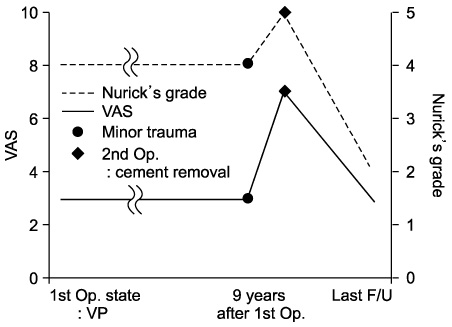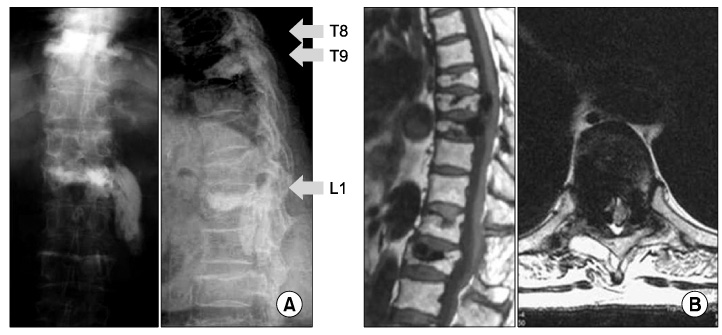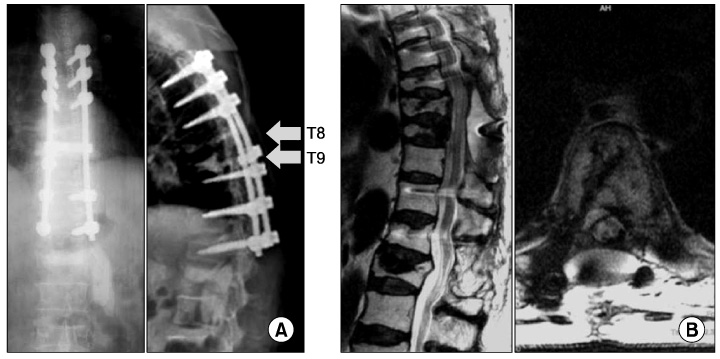J Korean Orthop Assoc.
2009 Jun;44(3):386-390. 10.4055/jkoa.2009.44.3.386.
Spinal Cord Injury Caused by Bone Cement after Percutaneous Vertebroplasty : One Case of Long-term Follow-up and the Result of Delayed Removal
- Affiliations
-
- 1Department of Orthopedic Surgery, Seoul Sacred Heart General Hospital, Seoul, Korea. niceosu@freechal.com
- KMID: 2186348
- DOI: http://doi.org/10.4055/jkoa.2009.44.3.386
Abstract
- Among the complications of percutaneous vertebroplasty, bone cement leakage into the spinal canal doesn't happen very often, but this could provoke a severe neurologic deficit. It is not certain whether this neurologic deficit may be permanent or reversible. Yet if the bone cement is left in the spinal canal, trivial events such as minor trauma could worsen the neurologic symptoms. The authors treated a 75-year-old female patient with Nurick's grade IV neurologic deficit, which was due to cement leakage into the spinal canal after previous vertebroplasty of T8 and T9. She had been having a neurologic deficit for 9 years, and it became aggravated after a minor trauma to Nurick's grade V. After the cement in the spinal canal was removed, her neurologic symptoms were improved to Nurick's grade II. Leaving a cement mass in the spinal canal may be a risk factor for additional neurologic injury even when suffering only a minor trauma, and the neurologic symptoms can be improved after removal of the cement, even for the case with a long-term neurological defect.
Keyword
MeSH Terms
Figure
Reference
-
1. Belkoff SM, Molloy S. Temperature measurement during polymerization of polymethylmethacrylate cement used for vertebroplasty. Spine. 2003. 28:1555–1559.
Article2. Cotten A, Dewatre F, Cortet B, et al. Percutaneous vertebroplasty for osteolytic metastases and myeloma: effects of the percentage of lesion filling and the leakage of methyl methacrylate at clinical follow-up. Radiology. 1996. 200:525–530.
Article3. Galibert P, Deramond H, Rosat P, Le Gars D. Preliminary note on the treatment of vertebral angioma by percutaneous acrylic vertebroplasty. Neurochirurgie. 1987. 33:166–168.4. Kim KT, Suk KS, Kim JM, Park KC. Root injury after percutaneous vertebroplasty in compression fracture: case report. J Korean Soc Spine Surg. 2001. 8:181–185.5. Nurick S. The natural history and the results of surgical treatment of the spinal cord disorder associated with cervical spondylosis. Brain. 1972. 95:101–108.
Article6. Ryu KS, Park CK, Kim MC, Kang JK. Dose-dependent epidural leakage of polymethylmethacrylate after percutaneous vertebroplasty in patients with osteoporotic vertebral compression fractures. J Neurosurg. 2002. 96:Suppl 1. S56–S61.
Article7. Schmidt R, Cakir B, Mattes T, Wegener M, Puhl W, Richter M. Cement leakage during vertebroplasty: an underestimated problem? Eur Spine J. 2005. 14:466–473.
Article8. Shapiro S, Abel T, Purvines S. Surgical removal of epidural and intradural polymethylmethacrylate extravasation complicating percutaneous vertebroplasty for an osteoporotic lumbar compression fracture. Case report. J Neurosurg. 2003. 98:Suppl 1. S90–S92.9. Teng MM, Cheng H, Ho DM, Chang CY. Intraspinal leakage of bone cement after vertebroplasty: a report of 3 cases. ANJR Am J Neuroradiol. 2006. 27:224–229.10. Wu CC, Lin MH, Yang SH, Chen PQ, Shih TT. Surgical removal of extravasated epidural and neuroforaminal polymethylmethacrylate after percutaneous vertebroplasty in the thoracic spine. Eur Spine J. 2007. 16:326–331.
Article
- Full Text Links
- Actions
-
Cited
- CITED
-
- Close
- Share
- Similar articles
-
- Lumbar Root Injury by the Leakage of Bone Cement after the Percutaneous Vertebroplasty: A case report
- Multidetector CT Findings of Polymethylmethacrylate Cement Leakage Inducing Inferior Vena Cava Thrombosis: A Case Report
- Fatal Hemothorax Following Percutaneous Vertebroplasty: A Case Report
- The Fate of Injected Cement on Percutaneous Vertebroplasty
- Transcatheter Removal of Bone Cement Embolism in the Right Atrium after Percutaneous Vertebroplasty: The Embolus Broke in Half and Migrated to the Right Pulmonary Artery Intraoperatively






